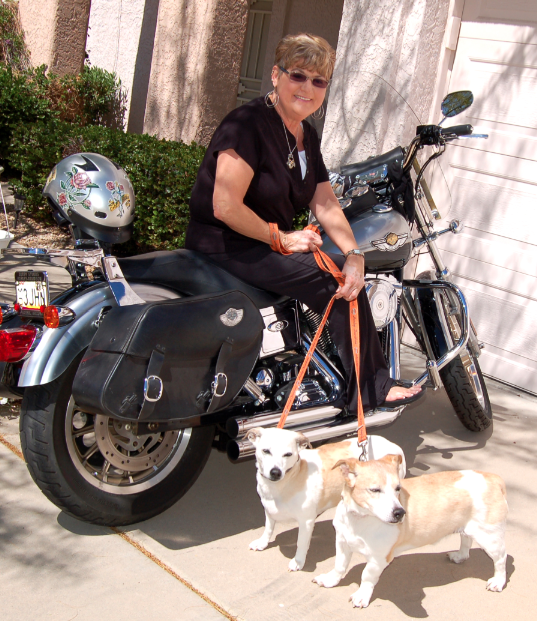If the American Academy of Neurology – the 25,000-member international professional association for neuroscience professionals – were to add a new category, “neuro-detective,” to its roster of subspecialties, at least three of John C. Lincoln’s neurological physicians would surely qualify.

Not Quite Ready to Ride The sparkly-rose decorated helmet that says "Lady Biker" and the deep-throated Harley engine both seem ready to roll out and go, but Floretta Hess is waiting until she’s stronger, after healing from a difficult-to-diagnose broken neck, before deciding whether to ride her bike again. Meantime, her Corgi-Jack Russell mix companions Cody and Cheyenne keep her company and keep her entertained.
Like the original consulting scientific detective, Sherlock Holmes, they meticulously ruled out all of the impossible causes of their patient’s problem and were left with a solution that while unexpected, was the truth. Maybe Dr. John Watson, Sherlock’s biographer, should be writing this story!
It all started several days after Glendale resident Floretta Hess received a flu shot. “My arms started aching, but I’m 66, so I just shrugged it off,” the USAA retiree said. “I thought it was probably just arthritis acting up.”
But the days went on and the pain didn’t go away. It got worse. Her arms and legs became numb and progressively weaker, to the point she was losing her ability to walk. Finally, after three weeks of increasing discomfort, she got a close friend to take her to the Emergency Department at John C. Lincoln Deer Valley Hospital.
“They did a bunch of tests that indicated I might have Guillain-Barre syndrome. That made sense to me because I’ve had Addison’s disease for years,” she said. Both diseases can be associated with dysfunctions in the body’s own immune system.
Addison’s can be caused when the immune system attacks the adrenal cortex. Guillain-Barre is a serious disorder that occurs when the body’s immune system attacks the nervous system, causing nerve inflammation that causes pain and extreme muscle weakness. On rare occasions, Guillain-Barre can be triggered by a flu shot.
The Deer Valley ED staff ordered emergency transport for Hess to be taken to North Mountain, where neuro-intensivist Victor Zach, MD, neurologist Islam Abujubara, MD, and neurosurgeon Igor Yusupov, MD, awaited her arrival.
“Upon receiving her in our Intensive Care Unit,” Dr. Zach said, “I conducted a careful neurologic exam that showed she had four out of five findings consistent with Guillain-Barre syndrome.
“However,” Dr. Zach added, “one finding, her deep tendon reflex, was the opposite of what’s found in Guillain-Barre – instead of reduced functioning of the reflexes, hyporeflexia, she had hyperreflexia, or overactive reflexes.
“I told her then that although she had four out of five signs for Guillain-Barre syndrome, the fact that she had jumpy reflexes made me concerned that something else was going on. That’s why we needed to get an MRI before starting treatment for Guillain-Barre,” Dr. Zach said.
Guillain-Barre is treated with plasma exchange therapy, in which a large catheter is inserted by Dr. Zach into the jugular vein to flush harmful antibodies from the patient’s blood stream. Because it is a complex procedure, the staff had been preparing to start it while Dr. Zach was still evaluating the patient.
Based on Hess’ overactive reflexes, Dr. Zach aborted the catheterization and ordered an MRI of her cervical spine (neck and upper back).
“Discovering hyperreflexia,” Dr. Zach said, “I immediately suspected spinal cord compression due to a broken neck. Addison’s disease is treated with steroids, and long-term use of steroids can weaken bones over time.
“I heard him yell ‘Get her in a collar now!’” Hess recalled.
“If she moved the wrong way with a broken neck, she could have been immediately and completely paralyzed,” Dr. Zach explained. “To protect her while we did further testing, her neck had to be immobilized in a hard collar.”
The MRI only showed mild stenosis, a slight narrowing of the spaces within the vertebrae that house the spinal cord. Although that did not explain her symptoms, the team did not give up.
Dr. Zach consulted with Dr. Abujubara, who performed a nerve conduction study and electromyography (EMG) to evaluate the electrical activity of the nerves and to assess the function of the skeletal muscles. "Dr. Abujubara called me immediately," Dr. Zach said, "to report that, as we both suspected, this was not Guillain-Barre syndrome."
Dr. Zach ordered a flexion extension film to check for spinal instability.
“The results were shocking,” Dr. Zach said. “She had complete instability of her cervical spine – her cervical spine was detached from the lower vertebrae. It actually moved back and forth during flexion and extension of her neck.”
Dr. Yusupov immediately scheduled neck surgery for Hess to fixate and stabilize her neck with screws, rods and a plate. Because Addison’s disease patients may experience shock in surgery due to their inability to produce certain hormones, Dr. Zach took special precautions in preparing Hess for surgery. He started replacement hormones on the day prior to surgery and inserted a central venous catheter to have quick access to her circulation in case her blood pressure became dangerously low.
To everyone’s relief – and joy – Hess sailed safely through surgery, and miraculously all her symptoms went away, Dr. Zach reported.
Say what? “Oh, yes,” she said. “I have a Harley. My children and grandchildren think I ought to give it up, but I’m not sure. I can’t ride it until I get stronger, so we’ll see what I decide then.”
While working with her physical therapist to regain strength and physical conditioning, Hess enjoys short trips and socializing with friends – and playing with her active Jack Russell-Corgi mix dogs, Cody and Cheyenne.
“My grown children and grandchildren are all back in Pennsylvania, and they’re pushing me to move back to be closer to them. But I’m lucky to have a great support group of friends, here. I don’t think I’m ready to move into that mother-in-law casita next to my daughter’s house, yet,” she smiled.
